Physical Address
304 North Cardinal St.
Dorchester Center, MA 02124
In order for a person to perceive facial pain, there must be a peripheral nerve pathway for neural impulses to travel from the site of injury into the central nervous system. The classic facial pain, “trigeminal neuralgia” or “tic doloureux” is not what this chapter is about, as that perceived pain originates within the central nervous system. Facial injury most often involves branches of the trigeminal nerve (TN) to the forehead (frontal branch, V 1 ), midface (maxillary branch, V 2 ), and mandible (mandibular branch, V 3 ) ( Fig. 3.15.1 ).
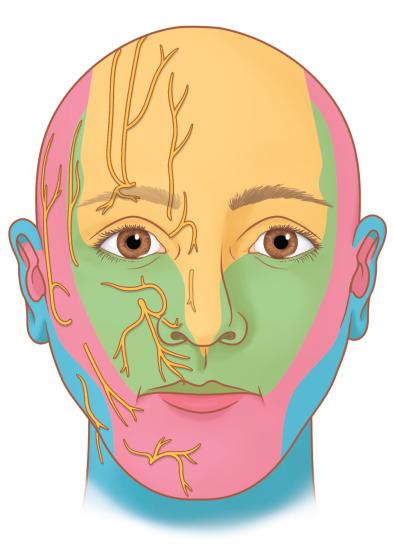
There is no published epidemiologic study about the incidence or prevalence of posttraumatic facial pain. The most recently reported description of 21,000 craniofacial injuries in almost 10,000 patients did not include facial pain. There have been observational studies related to the frontal bone (V 1 ) where 5 (13%) of 43 patients had chronic frontotemporal “headache pain.” These patients each had a fracture of the anterior table of the frontal sinus. In another observational study, related to zygoma fractures (V 2 ), 76% of 25 patients, at a mean of 6.3 months post-injury, were found to have abnormal cutaneous pressure thresholds in the distribution of the infraorbital nerve on the side with the fracture. The difference between the 13% prevalence of facial pain, and the 76% prevalence of sensory abnormalities is due to the difference in the question asked and the method of investigation in the study of craniomaxillofacial trauma.
While the TN is a cranial nerve, once its branches leave the cranium, they become covered with Schwann cells, and therefore behave like a peripheral nerve in that they can regenerate. If they can regenerate, then they can form a painful neuroma. This insight provides the basis of treatment of painful neuromas of the trigeminal nerve. While injuries and painful sequelae of injured trigeminal nerves have been described classically, and those descriptions remain valid, what remains unresolved is the surgical approaches to treat injuries to V 1 ,V 2 , and V 3 . An approach to the treatment of posttraumatic facial pain has been described in which the TN is considered as a peripheral nerve.
As with every peripheral nerve injury, if the nerve provides sensibility to an area of critical importance, like the lip, then reconstruction is the appropriate surgical choice. If the nerve does not provide critical sensibility to an area, like the forehead, then interruption of nerve function, with appropriate treatment to the proximal end of the nerve, is the surgical choice. The “appropriate treatment” for the proximal end of the injured TN will be discussed in detail later in this chapter ( Box 3.15.1 ).
If a nerve provides critical sensibility to an area, like the lip, then reconstruction is the appropriate surgical choice.
If a nerve does not provide critical sensibility to an area, like the forehead, then resection (interruption of function) of that nerve is the appropriate surgical choice.
For the purposes of this chapter on posttraumatic facial pain, the “face” will be defined as including skin that is innervated by branches of the cervical plexus, as these can be injured and the pain perceived as facial in origin ( Fig. 3.15.1 ). Also for the purposes of this chapter, “headaches,” including frontal, temporal, nasal, and occipital, will be included to provide a basis for approaching posttraumatic pain in a surgical manner distinct from the approach to the classic migraine, which is not posttraumatic in origin. Additionally, posttraumatic occipital injuries may give pain that radiates to the frontal region, and needs to be distinguished for diagnosis and appropriate treatment by doing nerve blocks ( Figs. 3.15.2 and 3.15.3 ) or Botox® (onabotulinumtoxinA) injections.
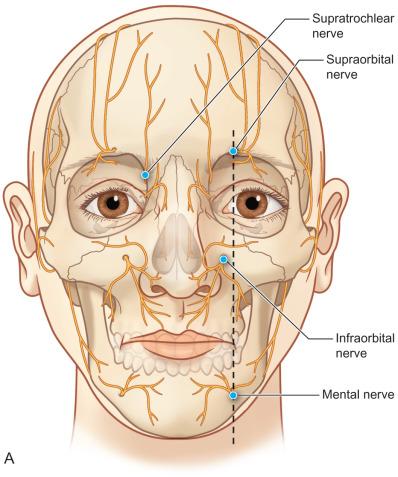
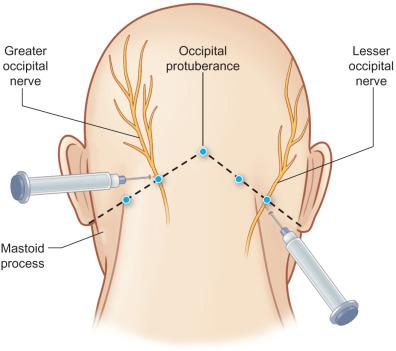
Aesthetic surgery of the face and neck can be considered as trauma, and, as such, this chapter will include facial pain that results secondary to cosmetic surgery, and the surgical approaches to correct this origin of posttraumatic facial pain.
Finally, this chapter will not include discussion of intrinsic temporomandibular joint (TMJ) disorders, although a peripheral nerve approach to denervation of the TMJ has been described ; nor will this chapter discuss other rare pain disorders, such as Eagle's syndrome (orofacial pain related to the stylohyoid ligament), or persistent burning mouth syndrome.
Posttraumatic facial pain must first be proven to be due to an injury to a peripheral nerve that is part of the craniofacial skeleton. This implies that there has to be a history of trauma to the head and neck region. A history of facial or cranial surgery is a history of trauma.
In obtaining the history from the patient, the most commonly overlooked source of posttraumatic facial pain is previous neurosurgery procedures , such as those for Chiari malformation ( Fig. 3.15.4A ), that require incisions at the base of the occiput, or those for brain tumor, such as acoustic neuroma, which are in the postauricular, mastoid area. Other less common causes related to neurosurgery are cerebrospinal shunt placements, burr holes, and the anterior site of tong placements. The next most frequently missed history point is a previous motor vehicle accident with a whiplash injury, which can cause pain related to the anterior scalene becoming adherent to the cervical and brachial plexus, or with an airbag inflation. Be sure to ask about childhood injuries to the craniofacial skeleton, such as a baseball ( Fig. 3.15.4B ) hitting the face, a fall from a bike, or other sports accidents, which must include heading a ball in soccer and concussion. Especially if the pain is related to V 2 or V 3 , inquire about dental surgery, particularly dental implants ( Fig. 3.15.4C ). Finally, when asking about previous facial surgery, ask directly about cosmetic surgery such as facelift ( Fig. 3.15.4D ), cheek implants, or jaw surgery, such as chin implant or orthognathic surgery.
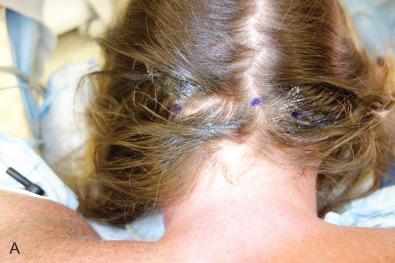
Compression of the trigeminal ganglion or its nerve roots intracranially will cause facial pain that will not be relieved by a nerve block of the peripheral TN branches. It is now accepted that traditional trigeminal neuralgia is a vascular compression of the Gasserian ganglia roots by a branch of the inferior cerebellar artery, which is best treated by an intracranial vascular decompression, as originally described by Jannetta, in 1967. Therefore, a nerve block, as depicted in Fig. 3.15.2 , will document that pain is from an injury to a peripheral branch of the TN, and not from intracranial vascular compression if (1) the expected skin territory goes numb after the local anesthetic is injected, and if (2) the pain is relieved. This holds true for nerve blocks to the cervical plexus ( Fig. 3.15.2 , and the occipital nerves ( Fig. 3.15.3 ).
While the computed tomography (CT) scans usually cannot demonstrate nerves directly, the injury to a bone adjacent to the known anatomical location of a nerve supports the diagnosis of posttraumatic facial pain due to that nerve. This is demonstrated in Fig. 3.15.5A where the left orbital floor is lower than it is on the right, and the infraorbital canal is deformed on the left. In Fig. 3.15.5B , the right infraorbital nerve is injured at the location of the fixation plate at the infraorbital rim. Another example is given in Fig. 3.15.6 , where the right inferior alveolar nerve was injured twice; the first time with a screw designed to hold a bone graft prior to dental implant placement, and then a second time, when a metal clip was placed on the mental nerve at the mental foramen. The application of 3T MRI to the cranial nerves has brought a new dimension to being able to evaluate posttraumatic facial pain and is the best way to document vascular compression of the trigeminal ganglia and its roots.
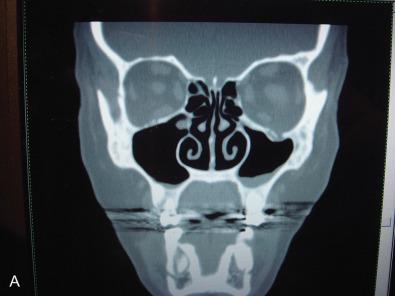
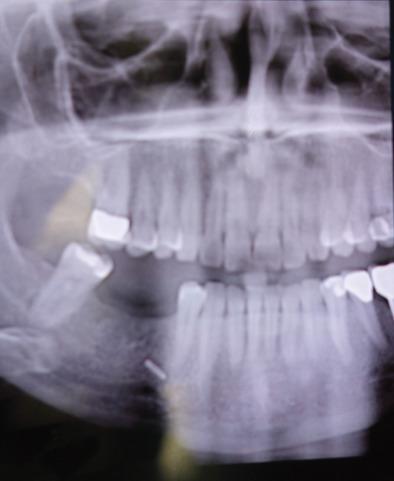
An injured sensory nerve will develop a pattern of function that relates to the degree of nerve compression and a pattern that can identify nerve regeneration. Normative data for the one-point static- and moving-touch, and two-point static- and moving-touch was reported in 2007 using the Pressure-Specified Sensory Device™. The use of this device (previously marketed by Sensory Management Services, Inc., Baltimore, MD, now marketed as AcroVal™ Neurosensory and Motor Testing Systems by Axogen, Inc., Alachua, FL) has been reviewed extensively recently. By measuring the cutaneous pressure threshold of appropriate target skin areas, a patient's subjective complaints can be documented, as related to complete loss of function, compression, or nerve regeneration for trigeminal nerve branches, as illustrated in Figs. 3.15.7–3.15.9 .
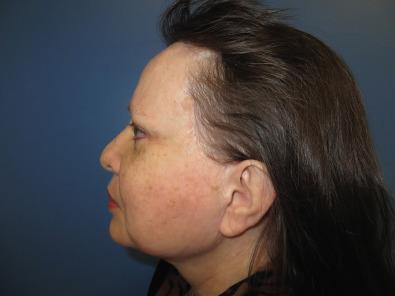
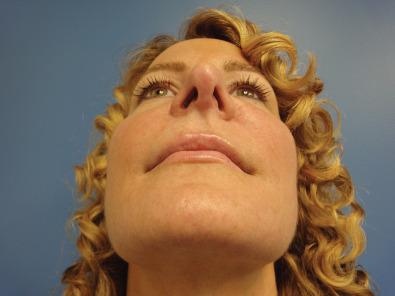
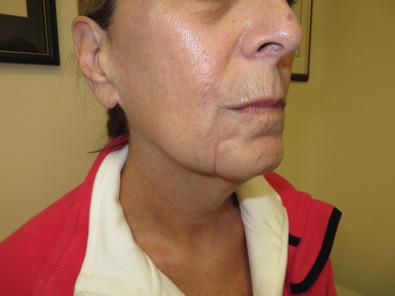
Become a Clinical Tree membership for Full access and enjoy Unlimited articles
If you are a member. Log in here